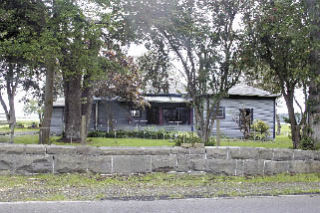A paperwork snafu led to a building permit being issued prematurely for a giant home in Ebey’s Landing Historical Reserve.
The mishap has caused consternation in Coupeville, where preservation of the rural working heritage of the land is taken very seriously.
The Trust Board of the Reserve, which includes many prominent Central Whidbey folk, issued a statement this week expressing disappointment with the plans for the house, which the members feel will “undermine the integrity of this important pioneer homestead.”
“The project as it stands is not in keeping with the spirit of the Island County standards that were established to preserve Island County’s regional history, architecture, scenic vistas and cultural heritage,” the letter states.
Coupeville resident Ian Jefferds, the recipient of the accidental permit, also applied for a demolition permit to raze a nearby structure that’s on the National Historical Register, though his hope and expectation is that someone will remove it from the property and preserve it instead.
Planner Director Jeff Tate explained that the Historic Review Committee has the responsibility of reviewing permits, with an eye to historic compatibility, and making a recommendation to planners.
In this case, Jefferds applied for a clearing and grading permit as well as a building permit for property on Wanamaker Road, overlooking Crockett Lake. He plans on building a home that will be 5,000 square feet, including the attached garage.
The committee, Tate said, approved the clearing and grading permit, but accidentally signed the paperwork for the building permit. Planning staff didn’t have any of their own concerns with Jefferds’ application, so the permit was issued.
James Moore, the chairman of the Historic Review Committee, said the members actually unanimously recommended denial of the building permit application. He said the county ordinance clearly doesn’t allow such a home to be built in the sensitive historic area.
“The purpose of the ordinance is to prevent the construction of McMansions that would be intrusive in scale,” he said.
Moore explained that the “decision sheet” that was erroneously signed simply had the wrong three-digit code on it. The other sheet, with the real decision, included a written explanation.
Nevertheless, Tate said the building permit cannot be revoked because the mistake wasn’t caught in time. The county has 21 days to take back a permit. The state Supreme Court even ruled in a similar case.
Jefferds said he simply applied for a building permit and received it without knowing anything about a paperwork mistake. In fact, he said what exactly happened is “a matter of interpretation.”
Jefferds met with the Historic Review Board last Thursday. Tate said Jefferds didn’t agree to make any additional changes to his design. He already had agreed to do certain things to “soften the impact” of the home, including landscaping to make it appear to be more than one building.
“He’s been civil and willing to talk, but not willing to be compliant,” Moore said.
How much of a difference the paperwork error really makes, however, is a matter of debate.
Moore said it’s obvious that a structure that large shouldn’t be allowed. The average size of homes in the Crockett Lake area, he said, is 1,600 square feet and 45 to 65 feet long. The Jefferds’ design is for a one-story, 122-foot long home with about 5,000 square feet of floor space, if the attached garage is included.
Tate, on the other hand, said his staff didn’t see any problems with the application, which was why it was approved without question. He said the profile of the home is low enough that it wouldn’t be visible from most roads in the area.
If the paperwork error didn’t happen, he said staff would probably have tried to work with the committee and Jefferds to figure out a compromise, though he said it likely wouldn’t have been as drastic as cutting the size of the home in half. Tate would ultimately have the final say.
The ordinance in question states: “The building massing and scale should be consistent with adjacent conforming structures and land forms. Buildings or structures that are not of usual form or shape historically found in the Reserve are not permitted in contributing areas.”
Jefferds is currently living in the historic Sam Crockett house next to the site where his new home will be built. He said he plans to give the building to someone willing to move it and preserve it.
“A couple of people already expressed interest,” he said. “Even if I get the demolition permit from the county, we still intend to try to find someone.”
Tate said the old home has had multiple additions over the years, but the original part is solid and of historical value. He said the county will likely issue the demolition permit.
The home was built on Sam Crockett’s donation land claim. In 1876, Crockett sold the land claim to Thomas Calhoun. Calhoun built the home in 1890, but part of it burned in 1897. He sold the house to Herman and Margaret Wanamaker, who lived in it from 1920 until 1981, according to Ebey’s Landing National Historical Reserve.



